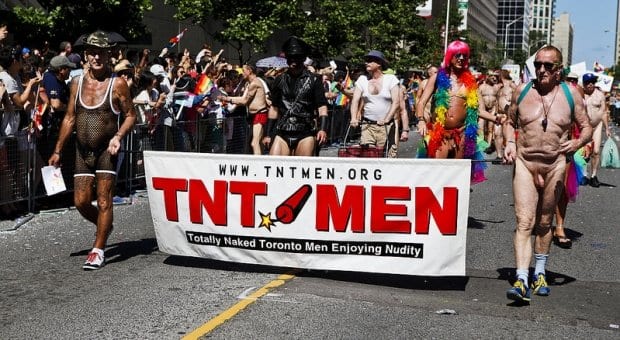When the Vancouver Pride Society (VPS) recently rejected Foreskin Pride’s application to march in its 2013 parade because founder Glen Callender tends to march pantsless, it cited Canada’s nudity laws, raising questions about censorship. Both city officials and Vancouver police confirmed they had no issues with public nudity at Pride, which meant the decision rested solely on VPS.
The president of the Federation of Canadian Naturists (FCN), Karen Grant, acknowledges that naturism occupies a tricky legal and social position in Canada. “Canadian law is open to interpretation as to what is considered ‘decent’ or ‘immoral,’” Grant says. “Given that much of Canada’s law-enforcement agencies are not even truly aware of the ruling that allows women to walk top-free, it’s always best to try naturism in a private or ‘safe’ place first.”
Although Callender was excluded from Vancouver Pride, naturism remains popular in the country — this summer the FCN celebrates its 10th annual FCN/FQN Festival. The Fédération québécoise de naturisme (FQN) was founded in 1977, and when the FCN found its feet almost a decade later, the two organizations partnered as official representatives to the International Naturist Federation.
Grant, who’s from a practising naturist family, became involved with the FCN after relocating from Alberta in 2009. She had a chance encounter with the editor of Going Natural magazine, which led to a move to Ontario, where she took on the presidency of the FCN and eventually a managerial position at the Bare Oaks Family Naturist Park in Sharon.
On top of privately owned resorts and campgrounds such as Bare Oaks, southern Ontario boasts Hanlan’s Point Beach in Toronto, one of two officially designated public clothing-optional beaches in Canada (the second is Wreck Beach in Vancouver). Going Natural, a quarterly news and lifestyle guide for naturists, first published in 1986; Bare Oaks also produces a monthly podcast, Naturist Living Show.
But while naturism remains popular, Grant’s words of caution to first-time nudists is justified; Canada’s nudity laws have often proven subjective. In 2012, an Ontario judge convicted Brian Coldin on five counts of public nudity after he ordered food at two Ontario drive-through windows while naked in his car. In the court proceedings, Nader Hasan represented Coldin and challenged the constitutionality of Canada’s nudity laws.
Hasan stresses that his team, which included high-profile lawyer Clayton Ruby, was never targeting the separate provisions against public indecency. They sought to challenge the overbroad nudity law of the Criminal Code in relation to harmless nudity. “If you can be seen from a public sidewalk while you’re bathing nude in your backyard, you are committing a Criminal Code offence,” Hasan says. “That’s just on a plain reading of Section 174. If you were to get out of the shower and walk past a window in your own home and someone could see you from the sidewalk because they happen to be walking by at that time, you will have committed a criminal offence.”
Whether people believe public nudity is good or bad is beside the point, Hasan says. “This case was about whether the sanction of a criminal penalty, which is the strongest, most aggressive, most coercive penalty that the state has against the individual, ought to be used to penalize harmless nudity.”
Judge Jon-Jo Douglas’s decision convicted Coldin on four counts of public nudity and did not accept the challenge against the constitutionality of the Criminal Code’s nudity laws, though he made several positive observations about practising naturists. Hasan maintains that nudity laws that carry the threat of imprisonment are a violation of our right to life, liberty and security of person: “I continue to believe that Section 174 is ripe to be challenged.”
Despite any legal anxieties, the FCN’s annual celebrations continue to grow. The FCN/FQN Festival, held at Bare Oaks, kicks off this year with a bus trip to Hanlan’s Point on Aug 7. The FCN used to take a caravan of vehicles to Oka Beach, an unofficial clothing-optional destination in Quebec, but when it relocated to Bare Oaks, Hanlan’s became the ideal beach destination.
“The bus trip has grown to two buses and possibly a third for this year’s festival,” Grant says. “We have become a bit of a legend, as folks have heard of the ‘naked bus’ that goes to the beach. We really do ride down in the nude, and we sit on the ferry on the bus in our skin.”
The festival also includes workshops and social events for families and children. Grant says the philosophies of naturism are as important as the nudity itself: “It would be easy to overthink this philosophy because so much of the world is tied up in body appearance and the sexual delivery of the body, but if one can bring it back to the simple idea of being, could we possibly eliminate some of the bigotry and body fear within society? Given the saneness and wholeness of naturism, perhaps we could.”
Canada v public nudity: Some legal advances and setbacks in Canada’s history of public nudity laws
1980
June – Female stripper charged with disorderly conduct under the Liquor Licence Act for removing clothing at the Central Hotel in Moose Creek, Ontario, though a Liquor Licensing Board of Ontario tribunal decision finds that “nudity as such does not constitute disorderly conduct.”
1991
July – Gwen Jacob charged with committing an indecent act for appearing topless in public.
1996
December – The Ontario Court of Appeal overturns Jacob’s conviction, though it did not rule on the constitutionality of the issue of women’s top freedom.
2000
March – After ongoing police harassment against Totally Naked Men Enjoying Nudity Toronto (TNTmen), charges are laid against The Barn nightclub for disorderly conduct under the Liquor Licence Act in relation to a naked dance party.
2002
April – After the work of a number of nudist/naturist organizations and activists on a three-year pilot project, Hanlan’s Point is officially designated as a clothing-optional beach.
June – Provincial Court Judge Robert Bigelow finds that allowing patrons to be naked is not in violation of Ontario liquor licence laws, dismissing charges against The Barn.
Days after Bigelow’s decision, police arrest seven men over allegations of “being nude in a public place” immediately following the Toronto Pride parade.
September – Crown attorney concedes no possibility of a conviction for public nudity in Pride parade arrests; no charges laid.
2009
May – Brian Coldin is one of two Bracebridge, Ontario, men charged with public nudity after allegedly appearing naked at Tim Hortons and A&W drive-through windows.
2011
August — A Toronto Festival of Beer security guard asks a female reveller to put her top back on so “guys don’t get the wrong idea.”
September – Twelve plainclothes officers arrest five men for public nudity at Meech Lake in Gatineau Park, Quebec.
Judge Jon-Jo Douglas upholds the constitutionality of Canada’s public nudity law, convicting Coldin on four out of five counts.
2012
May – Two of the “Meech Lake Five” are charged under Section 174 of the Criminal Code.
Summer – Three people are arrested in Gatineau Park in “Operation Nude,” one man and one woman for public nudity, and another man for an indecent act.
2013
July – The Vancouver Pride Society bans Foreskin Pride founder Glen Callender’s application to march, citing nudity laws, based on his marching pantsless in previous parades.
With files from Xtra, the Ottawa Citizen, the Federation of Canadian Naturists and Spike’s Naked Planet.
The FCN/FQN Festival
Thurs, Aug 8-Sun, Aug 11
Bare Oaks Family Naturist Park, 20237 Kennedy Rd, Sharon
fcn.ca
bareoaks.ca


 Why you can trust Xtra
Why you can trust Xtra


